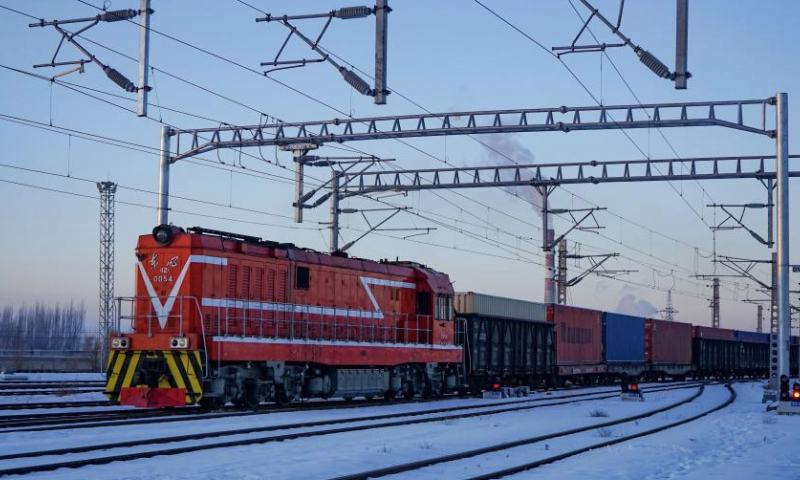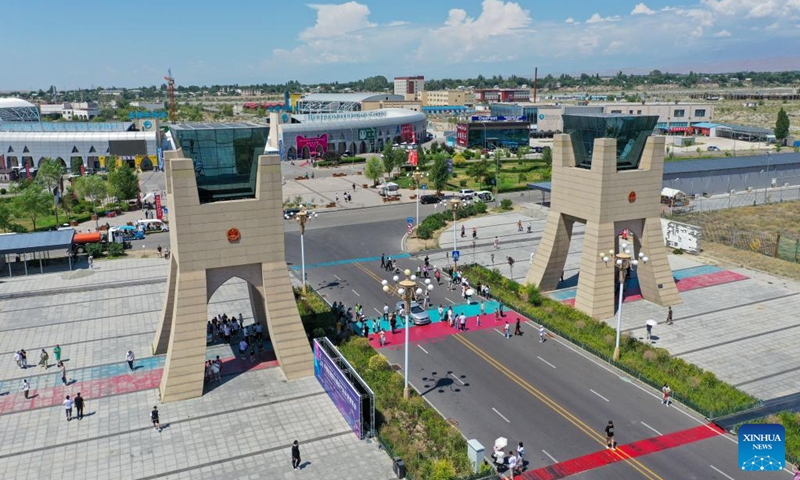
A China-Europe freight train bound for Kazakhstan passes through Horgos railway port in Horgos, northwest China's Xinjiang Uygur Autonomous Region, Dec. 25, 2024. Horgos Port, a major railway hub in Xinjiang, has facilitated 8,541 China-Europe freight train trips by Dec. 24 this year, according to statistics from the railway department of Horgos Port. Photo: Xinhua
The volume of passenger trips and cross-border freight transport at ports in Northwest China's Xinjiang Uygur Autonomous Region set new records in 2024, according to official data released on Sunday.
A total of 3.251 million inbound and outbound passenger trips were recorded, up 84.93 percent year-on-year, of which visa-free foreign visitors numbered 626,000, marking a 390 percent year-on-year surge, reported the Xinjiang Daily, citing statistics from the Xinjiang Exit-Entry Border Inspection General Station.
Vehicle, train and flight crossings totaling 1.362 million were recorded, a 56 percent year-on-year increase.
In 2024, several Xinjiang ports, including Horgos, Alashankou and Turgart, set records in passenger crossings and cargo flows.
The customs clearance number of entry-exit trains through Xinjiang's ports accounted for 40 percent of China's total railway port crossings, securing the top spot nationally, with Alashankou and Horgos taking the first and second slots, respectively.
In 2024, the number of China-Europe Railway Express freight trains passing through the Alashankou railway port totaled 7,684, up 15.8 percent year-on-year, a record high. The maximum number of trains in a single day was 29, with an average of 21 trains passing through daily, official statistics showed.
According to statistics from Horgos railway port, the number of freight trains under the China-Europe Railway Express passing through the port reached 8,730 in 2024, an increase of 12.5 percent year-on-year, and the shipment of goods reached 12.084 million tons, an increase of 10.9 percent year-on-year, both setting new records. The Horgos railway port served more than 22 China-Europe Railway Express trains per day.
So far, the total number of China-Europe Railway Express trains passing through the Horgos railway port has exceeded 40,000, and the total number of railway express routes reached 85, radiating out to 46 cities in 18 countries abroad, making Xinjiang an important logistics channel connecting China and Eurasia.
The China-Kazakhstan Horgos International Border Cooperation Center recorded 7.59 million passenger visits, an 81 percent increase from a year earlier. The Xinjiang region launched 24 new international passenger routes to connect with 17 countries and regions in 2024.

An aerial drone photo taken on July 26, 2024 shows a view of the Horgos International Border Cooperation Center on the China-Kazakhstan border in Horgos, northwest China's Xinjiang Uygur Autonomous Region. Since the implementation of mutual visa exemption between Kazakhstan and China in November 2023, Horgos Port has witnessed a substantial increase of entry and exit tourist trips. In recent days, the Horgos International Border Cooperation Center on the China-Kazakhstan border has ushered in the peak of border tourism. Photo: Xinhua
"Xinjiang's geographical advantages are being fully leveraged, and its ports present a flourishing landscape with a boost from the Belt and Road Initiative (BRI) and the China (Xinjiang) Pilot Free Trade Zone (FTZ)," Liu Peng, deputy head of the Xinjiang Exit-Entry Border Inspection General Station, was quoted as saying.
In 2023, China unveiled an overall plan for building a pilot FTZ in Xinjiang, aiming to make the region a model in the high-quality development of China's central and western regions, better serve the construction of the BRI core area, facilitate its role as a bridgehead for westward opening-up, and make a positive contribution to the joint building of a China-Central Asia community of a shared future. It was the first FTZ in China's northwestern border regions and the 22nd nationwide.
As a result, Xinjiang's foreign trade hit 403.11 billion yuan ($55.1 billion) from January to November in 2024, an increase of 26 percent year-on-year, according to customs data. The growth rate was the fastest across the country for the period.In 2025, Xinjiang plans to advance intelligent port construction and introduce smart border inspection systems to enhance border clearance efficiency further. Meanwhile, the region will continue to improve the level of immigration management, and ensure the smooth flow of cross-border personnel and goods through the ports, said Liu.
In order to increase the efficiency of port clearance, Xinjiang in 2024 introduced several dedicated channels, such as a specific channel for BRI-related cargo and agricultural products, and a green channel for livelihood products.
At railway ports, the "parallel check" of border inspection and customs clearance is being implemented, which has cut port crossing times by nearly 50 percent and reduced transportation costs by 30 percent.
Global Times



